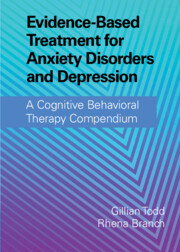 Evidence-Based Treatment for Anxiety Disorders and Depression
Evidence-Based Treatment for Anxiety Disorders and Depression Book contents
- Evidence-Based Treatment for Anxiety Disorders and Depression
- Evidence-Based Treatment for Anxiety Disorders and Depression
- Copyright page
- Contents
- Figures
- Tables
- Contributors
- 1 Introduction
- 2 The History and Philosophical Underpinnings of CBT:
- Part One Cognitive Behavioral Therapy for Anxiety Disorders
- Part Two Cognitive Behavioral Therapy for Posttraumatic Stress Disorder
- Part Three Cognitive Behavioral Therapy for Obsessive-Compulsive Disorder and Associated Disorders
- Part Four Cognitive Behavioral Therapy for Depression
- Part Five Complexity and Comorbidity in Anxiety Disorders and Depression:
- 22 Case Formulation for Complexity and Comorbidity in Anxiety Disorders and Depression
- 23 Treating Complexity and Comorbidity in Anxiety Disorders and Depression
- Part Six Specialist Applications of Cognitive Behavioral Therapy for Anxiety Disorders and Depression
- Part Seven Future Developments
- Appendices
- Index
- References
23 - Treating Complexity and Comorbidity in Anxiety Disorders and Depression
from Part Five - Complexity and Comorbidity in Anxiety Disorders and Depression:
Published online by Cambridge University Press: 06 January 2022
- Evidence-Based Treatment for Anxiety Disorders and Depression
- Evidence-Based Treatment for Anxiety Disorders and Depression
- Copyright page
- Contents
- Figures
- Tables
- Contributors
- 1 Introduction
- 2 The History and Philosophical Underpinnings of CBT:
- Part One Cognitive Behavioral Therapy for Anxiety Disorders
- Part Two Cognitive Behavioral Therapy for Posttraumatic Stress Disorder
- Part Three Cognitive Behavioral Therapy for Obsessive-Compulsive Disorder and Associated Disorders
- Part Four Cognitive Behavioral Therapy for Depression
- Part Five Complexity and Comorbidity in Anxiety Disorders and Depression:
- 22 Case Formulation for Complexity and Comorbidity in Anxiety Disorders and Depression
- 23 Treating Complexity and Comorbidity in Anxiety Disorders and Depression
- Part Six Specialist Applications of Cognitive Behavioral Therapy for Anxiety Disorders and Depression
- Part Seven Future Developments
- Appendices
- Index
- References
Summary
An effective, parsimonious way to treat patients who present with comorbid conditions and other complexities is to use process-based, generic CBT employing case conceptualization. This approach allows therapists to assess and target the patient’s maladaptive processes in functioning that may underlie several areas of diagnostic concern, and whose remediation may produce multiple clinical benefits. The case conceptualization serves as a road map to understand the patient’s subjective phenomenology, thus facilitating well-targeted interventions and abetting the therapeutic relationship. The case of Zina demonstrates how the patient’s avoidance strategies and maladaptive schemas played roles in her mood disorder (with suicidality), anxiety, eating disorder, substance use, and purging – and how all of these interfered with her life goals. The therapist prioritized Zina’s safety and attended closely to the therapeutic relationship. The case conceptualization helped illuminate ways to enhance Zina’s participation in treatment (including pharmacotherapy). Eighty sessions produced positive results.
Keywords
- Type
- Chapter
- Information
- Evidence-Based Treatment for Anxiety Disorders and DepressionA Cognitive Behavioral Therapy Compendium, pp. 475 - 504Publisher: Cambridge University PressPrint publication year: 2022
